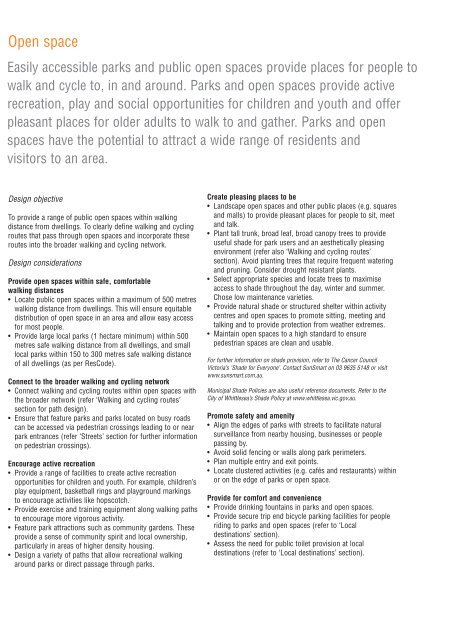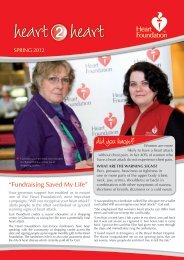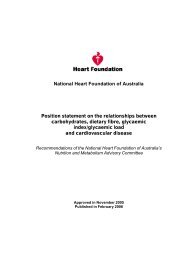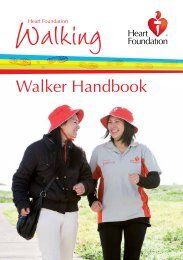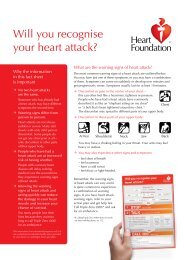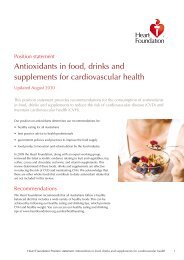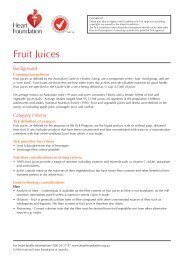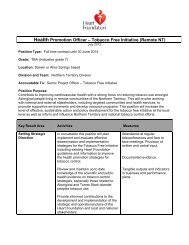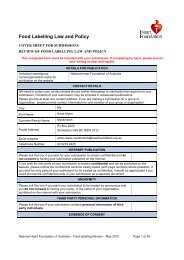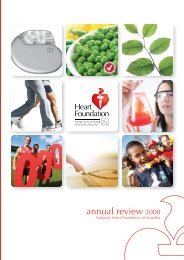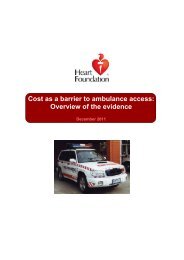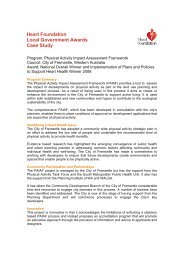Healthy by Design - National Heart Foundation
Healthy by Design - National Heart Foundation
Healthy by Design - National Heart Foundation
You also want an ePaper? Increase the reach of your titles
YUMPU automatically turns print PDFs into web optimized ePapers that Google loves.
Open space<br />
Easily accessible parks and public open spaces provide places for people to<br />
walk and cycle to, in and around. Parks and open spaces provide active<br />
recreation, play and social opportunities for children and youth and offer<br />
pleasant places for older adults to walk to and gather. Parks and open<br />
spaces have the potential to attract a wide range of residents and<br />
visitors to an area.<br />
<strong>Design</strong> objective<br />
To provide a range of public open spaces within walking<br />
distance from dwellings. To clearly define walking and cycling<br />
routes that pass through open spaces and incorporate these<br />
routes into the broader walking and cycling network.<br />
<strong>Design</strong> considerations<br />
Provide open spaces within safe, comfortable<br />
walking distances<br />
• Locate public open spaces within a maximum of 500 metres<br />
walking distance from dwellings. This will ensure equitable<br />
distribution of open space in an area and allow easy access<br />
for most people.<br />
• Provide large local parks (1 hectare minimum) within 500<br />
metres safe walking distance from all dwellings, and small<br />
local parks within 150 to 300 metres safe walking distance<br />
of all dwellings (as per ResCode).<br />
Connect to the broader walking and cycling network<br />
• Connect walking and cycling routes within open spaces with<br />
the broader network (refer ‘Walking and cycling routes’<br />
section for path design).<br />
• Ensure that feature parks and parks located on busy roads<br />
can be accessed via pedestrian crossings leading to or near<br />
park entrances (refer ‘Streets’ section for further information<br />
on pedestrian crossings).<br />
Encourage active recreation<br />
• Provide a range of facilities to create active recreation<br />
opportunities for children and youth. For example, children’s<br />
play equipment, basketball rings and playground markings<br />
to encourage activities like hopscotch.<br />
• Provide exercise and training equipment along walking paths<br />
to encourage more vigorous activity.<br />
• Feature park attractions such as community gardens. These<br />
provide a sense of community spirit and local ownership,<br />
particularly in areas of higher density housing.<br />
• <strong>Design</strong> a variety of paths that allow recreational walking<br />
around parks or direct passage through parks.<br />
Create pleasing places to be<br />
• Landscape open spaces and other public places (e.g. squares<br />
and malls) to provide pleasant places for people to sit, meet<br />
and talk.<br />
• Plant tall trunk, broad leaf, broad canopy trees to provide<br />
useful shade for park users and an aesthetically pleasing<br />
environment (refer also ‘Walking and cycling routes’<br />
section). Avoid planting trees that require frequent watering<br />
and pruning. Consider drought resistant plants.<br />
• Select appropriate species and locate trees to maximise<br />
access to shade throughout the day, winter and summer.<br />
Chose low maintenance varieties.<br />
• Provide natural shade or structured shelter within activity<br />
centres and open spaces to promote sitting, meeting and<br />
talking and to provide protection from weather extremes.<br />
• Maintain open spaces to a high standard to ensure<br />
pedestrian spaces are clean and usable.<br />
For further information on shade provision, refer to The Cancer Council<br />
Victoria’s ‘Shade for Everyone’. Contact SunSmart on 03 9635 5148 or visit<br />
www.sunsmart.com.au.<br />
Municipal Shade Policies are also useful reference documents. Refer to the<br />
City of Whittlesea’s Shade Policy at www.whittlesea.vic.gov.au.<br />
Promote safety and amenity<br />
• Align the edges of parks with streets to facilitate natural<br />
surveillance from near<strong>by</strong> housing, businesses or people<br />
passing <strong>by</strong>.<br />
• Avoid solid fencing or walls along park perimeters.<br />
• Plan multiple entry and exit points.<br />
• Locate clustered activities (e.g. cafés and restaurants) within<br />
or on the edge of parks or open space.<br />
Provide for comfort and convenience<br />
• Provide drinking fountains in parks and open spaces.<br />
• Provide secure trip end bicycle parking facilities for people<br />
riding to parks and open spaces (refer to ‘Local<br />
destinations’ section).<br />
• Assess the need for public toilet provision at local<br />
destinations (refer to ‘Local destinations’ section).


